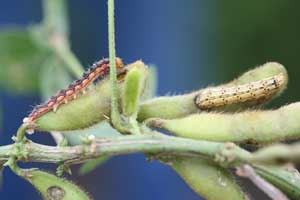Corn Earworm Appearing In State
COLUMBIA, MO.
Many late-planted and double-crop soybean fields in Missouri are at
risk of damage from corn earworm, also known as soybean podworm, said
University of Missouri Extension entomologist Wayne Bailey. Scout fields
now because conditions are right for the development of economic
infestations, he said.
“Corn earworm actually has more potential to reduce soybean yield
than corn yield,” Bailey said. Corn earworm can reduce corn yields by
feeding on kernels at the ear tip. It damages soybean by feeding on
foliage and pods.
Most damage occurs to pods and seeds. This can result in delayed seed production and lower yields.
Small larvae feed on soybean foliage first. They can chew through
pods to eat developing beans or cut pods from the plants. In very high
numbers, larvae can eat pods that have dropped to the ground. This can
cause up to 100 percent yield reduction of soybean, Bailey said.

Soybean podworms chew holes in soybean
pods and can significantly hurt the crop's yield.
Credit: Courtesy of Wayne Bailey, MU Extension
Double-crop soybean fields throughout the state, especially in southern Missouri, are most vulnerable to podworm damage.
Check soybean fields several times weekly for foliage feeding, pod
damage and presence of soybean podworm larvae. The best scouting methods
for this pest are direct observation, or use of a shake cloth or sweep
net, Bailey said.
There is a narrow window of time for treatment. “Larval infestations
from earlier moth flights of soybean podworm can do a lot of damage,” he
said.
Soybean podworm/corn earworm also can reduce sweet corn and field
corn yields and damage cotton and sorghum. There are two to three
generations per year in Missouri. This insect pest has many names
related to the crops on which it feeds.
Soybean podworm do not present an economic threat to Missouri soybean
in most years. Podworm problems could be greater this year because of
more late-planted soybean acres due to spring precipitation. Another
factor in 2014 is the lack of green cloverworm. Its larvae serve as an
early-season host of a beneficial fungus responsible for most soybean
podworm mortality later in the season.
Corn earworm remains a problem for Missouri corn producers as well.
MU Extension agronomy specialist Jill Scheidt in Barton County said last
week that she scouted a cornfield and found five earworms for every 10
stalks.
Once the worm has gotten into the corn ear, rescue treatments are often economically impractical and difficult, Bailey said.
The best option to prevent earworm in corn is to plant hybrid
varieties containing a Bt gene for control of this pest, he said.
Earworms keep their own numbers down in individual corn ears as large
worms eat smaller ones. Generally, there will be from one to three
worms per ear tip.
Bailey said yield loss for corn varies by study. Estimates are as
high as 8 percent, but 2 percent or less is probably more realistic, he
said. ∆